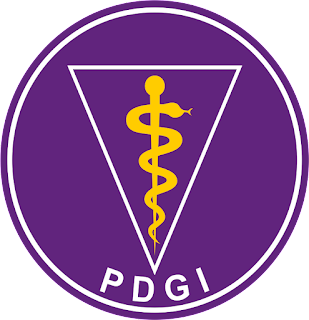The effect of trigona spp. Propolis extract to saliva substitute ph as xerostomia therapy
Abstract
Method: This study was experimental laboratory, namely Post-test only Control Group Design. The propolis Trigona spp. extract used in this study was extracted using maceration method with 70% ethanol as solvent which was then diluted into 5 concentrations 1,25%, 2,5%, 5%, 10%, 20%. This study used Streptococcus mutans (ATCC 25175) and saliva substitute with pH of 6.8. The research includes phytochemical test, absorbance measurement and pH test.
Result: There is a significant difference in the pH value between saliva substitute induced with Streptococcus mutans with Trigona spp. propolis extract and the control group. Data analysis using One-way ANOVA test showed a significant value of <0.001 (p<0.05).
Conclusion: Trigona spp. propolis extract is able to increase the pH of saliva substitute as xerostomia therapy, as the higher the concentration of Trigona spp. propolis extract, the higher the pH of saliva substitute. Samples with Trigona spp. propolis extract has the highest average pH value.
Keywords
Full Text:
PDFReferences
Rahmawati A. Pengaruh Pemberian Permen Karet yang Mengandung Xylitol Terhadap Penurunan Keluhan Xerostomia Pada Pasien Dengan Radioterapi Kepala dan Leher. 2013 Jul;25.
Shinta FDAI, Dinar N, Susanto H, Agustina D. Unstimulated Salivary Flow Rate Corresponds with Severity of Xerostomia: Evaluation using Xerostomia Questionnaire and Groningen Radiotherapy- Induced Xerostomia Questionnaire. Journal of Dentistry Indonesia. 2014 Jul 7;21(1):5–10.
Apriani A, Mandalas HY, Khoe W. Saliva Acidicity Level Toward Application Casein Phosphopeptide - Amorphous Calcium Phosphate For Children Aged 8-9 Years. ODONTO: Dental Journal. 2021;8(2):91–6.
Åysik D, Niemirowicz-Laskowska K, Bucki R, Tokajuk G, Mystkowska J. Artificial saliva: Challenges and future perspectives for the treatment of xerostomia. Int J Mol Sci. 2019 Jun;20(13):5–9.
Alishia I. Pengaruh Ekstrak Etanol Daun Lidah Buaya (Aloe vera L.) Terhadap Derajat Keasaman (pH) Saiva Buatan yang Diinduksi Streptococcus mutans secara In Vitro. [Malang]: Universitas Brawijaya; 2019.
Rezki S, P. Pengaruh pH Plak Terhadap Angka Kebersihan Gigi dan Angka Karies Gigi Anak di Klinik Pelayanan Asuhan Poltekkes Pontianak Tahun 2013. ODONTO: Dental Journal. 2014;1(2):13–8.
Belenguer-Guallar I, Jiménez-Soriano Y, Claramunt-Lozano A. Treatment of recurrent aphthous stomatitis. A literature review. J Clin Exp Dent. 2014;6(2):168–74.
Khurshid Z, Naseem M, Zafar MS, Najeeb S, Zohaib S. Propolis: A natural biomaterial for dental and oral healthcare. J Dent Res Dent Clin Dent Prospects. 2017;11(4):265–74.
Abdelrazeg S, Hussin H, Salih M, Shaharuddin B. Propolis composition and applications in medicine and health. International Medical Journal. 2020 Mar;25(3):1505–42.
Syaravina CB, Amalina R, Hadianto E. Pengaruh Ekstrak Daun Beluntas (Pluchea indica (L.) Less) 25% Terhadap Biofilm Streptococcus mutans - in vitro. ODONTO : Dental Journal. 2018;5(1):28–33.
Sariyem, Sadimin, Yuwana RP. Pengaruh Mengkonsumsi Larutan Propolis Terhadap pH Saliva. Jurnal Kesehatan Gigi. 2014 Dec;01(1):47–52.
Endang Zainal Hasan A, Mangunwidjaja D, Candra Sunarti T, Suparno O, Setiyono A. Optimasi Ekstraksi Propolis Menggunakan Cara Maserasi Dengan Pelarut Etanol 70% Dan Pemanasan Gelombang Mikro Serta Karakterisasinya Sebagai Bahan Antikanker Payudara. Jurnal Teknologi Industri Pertanian. 2013;23(1):13–21.
Supriyanto, BW S, I.M R, Yunianta. Uji fitokimia dan aktivitas antioksidan ekstrak daun mimba (Azaradiracta indica juss). Prosding Snatif. 2017;4:523–8.
Ramli HK, Yuniarti T, Lita NPSN, Sipahutar YH. Uji Fitokimia Secara Kualitatif Pada Buah dan Ekstrak Air Buah Mangrove. Jurnal Penyuluhan Perikanan dan Kelautan. 2020;14(1):1–12.
Carpenter G. Dry mouth: A Clinical Guide on Causes, Effects and Treatments. Springer. 2015;(September 2015):96.
Kasuma N. Fisiologi dan Patologi Saliva. Vol. 2, 2. Padang: Andalas University Press; 2015. 31–33 p.
Puteri PS, Oktiani BW, Aspriyanto D. Efektivitas Antibakteri Ekstrak Daun Rambai (Sonneratia caseolaris) Terhadap Pertumbuhan Bakteri Porphyromonas gingivalis. Dentin (Jurnal Kedokteran Gigi). 2022;6(3):146–52.
Neldawati, et al 2013. Analisis Nilai Absorbansi dalam Penentuan Kadar Flavonoid untuk Berbagai Jenis Daun Tanaman Obat Neldawati, Ratnawulan dan Gusnedi. PILLAR OF PHYSICS. 2013;2:76–83.
Puspitaningrum D. Pengaruh Ekstrak Etanol Buah Pir (Pyrus communis) Terhadap pH Saliva Buatan Yang Diinduksi Streptococcus mutans Secara In Vitro. [Malang]: Universitas Brawijaya; 2019.
Astutiningsih C, Setyani W, Hindratna H. Uji Daya Antibakteri dan Identifikasi Isolat Senyawa Katekin Dari Daun Teh (Camellia sinensisL. var Assamica). Jurnal farmasi sains dan komunitas. 2014;11(2):50–7.
Wardaniati I, Gusmawarni V. Uji Aktivitas Antibakteri Ekstrak Etanol Propolis Terhadap Streptococcus Mutans. Jurnal Farmasi Higea. 2021;13(2):115–23.
Warokka KE, Wuisan J, J. Uji konsentrasi hambat minimum (KHM) ekstrak daun binahong (Anredera cordifolia Steenis) sebagai antibakteri terhadap pertumbuhan Streptococcus mutans. e-GIGI. 2016;4(2):1–5.
Ruiz-Linares M, Ferrer-Luque CM, Arias-Moliz T, de Castro P, Aguado B, Baca P. Antimicrobial activity of alexidine, chlorhexidine and cetrimide against Streptococcus mutans biofilm. Ann Clin Microbiol Antimicrob. 2014;13(1):41.
Novita M, Arya W, Firdaus K, Taufiqurrahman I. Antibacterial Effectiveness of Stenochlaena palustris Leaves Extract Against The Growth of Streptococcus mutans. Jur Ked Gigi). 2022 Sep 2;(2).
DOI: http://dx.doi.org/10.30659/odj.10.1.117-124
Refbacks
- There are currently no refbacks.

This work is licensed under a Lisensi Creative Commons Atribusi-BerbagiSerupa 4.0 Internasional.
Contact us: Odonto Dental Journal: Jl. Raya Kaligawe Km.4, PO BOX 1054/SM Semarang, Central Java, Indonesia, 50112. Email: odontodentaljournal@unissula.ac.id



